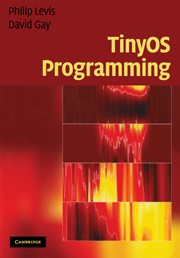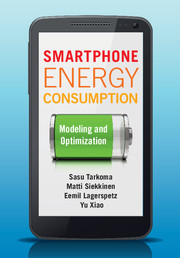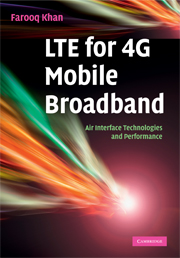TinyOS Programming
- Authors:
- Philip Levis, Stanford University, California
- David Gay, Intel Research, Berkeley
- Date Published: April 2009
- availability: Available
- format: Paperback
- isbn: 9780521896061
Paperback
Other available formats:
eBook
Looking for an examination copy?
This title is not currently available for examination. However, if you are interested in the title for your course we can consider offering an examination copy. To register your interest please contact [email protected] providing details of the course you are teaching.
-
Do you need to know how to write systems, services, and applications using the TinyOS operating system? Learn how to write nesC code and efficient applications with this indispensable guide to TinyOS programming. Detailed examples show you how to write TinyOS code in full, from basic applications right up to new low-level systems and high performance applications. Two leading figures in the development of TinyOS also explain the reasons behind many of the design decisions made and, for the first time, how nesC relates to and differs from other C dialects. Handy features such as a library of software design patterns, programming hints and tips, end-of-chapter exercises, and an appendix summarizing the basic application-level TinyOS APIs make this the ultimate guide to TinyOS for embedded systems programmers, developers, designers, and graduate students.
Read more- Complete code examples show how to write sensor network (TinyOS) code in full
- Programming hints and tips help you to write efficient applications
- A library of software design patterns and a summary of basic application-level Tiny OS APIs are included for convenient look up
Customer reviews
Not yet reviewed
Be the first to review
Review was not posted due to profanity
×Product details
- Date Published: April 2009
- format: Paperback
- isbn: 9780521896061
- length: 282 pages
- dimensions: 248 x 174 x 14 mm
- weight: 0.56kg
- contains: 5 b/w illus.
- availability: Available
Table of Contents
Programming hints
Preface
Acknowledgements
Part I. TinyOS and NesC:
1. Introduction
2. Names and program structure
Part II. Basic Programming:
3. Components and interfaces
4. Configurations and wiring
5. Execution model
6. Applications
7. Mote-PC communication
Part III. Advanced Programming:
8. Advanced components
9. Advanced wiring
10. Design patterns
11. Concurrency
12. Device drivers and the hardware abstraction architecture (HAA)
13. Advanced applications: SoundLocalizer
Appendix: TinyOS APIs
Bibliography
Index.
Sorry, this resource is locked
Please register or sign in to request access. If you are having problems accessing these resources please email [email protected]
Register Sign in» Proceed
You are now leaving the Cambridge University Press website. Your eBook purchase and download will be completed by our partner www.ebooks.com. Please see the permission section of the www.ebooks.com catalogue page for details of the print & copy limits on our eBooks.
Continue ×Are you sure you want to delete your account?
This cannot be undone.
Thank you for your feedback which will help us improve our service.
If you requested a response, we will make sure to get back to you shortly.
×





